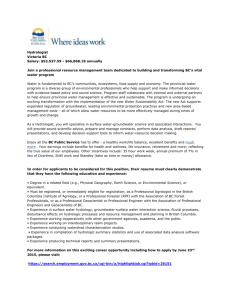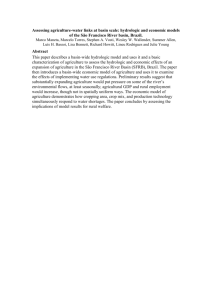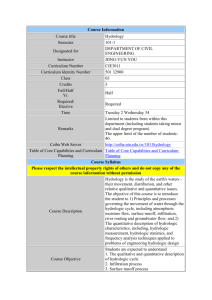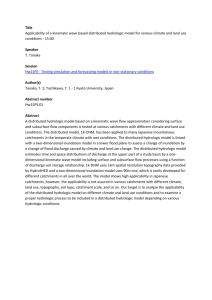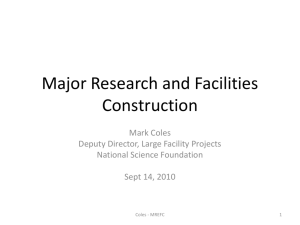Water for a Thirsty World
advertisement
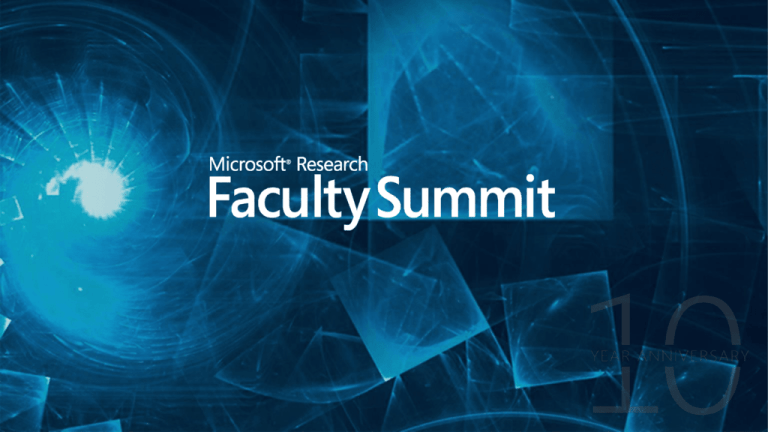
Grand Challenges Hydrologic Sciences: Closing the water balance How is fresh water availability changing, and how can we understand and predict changes? Engineering: Integration of built environment water system How can we engineer water infrastructure to be reliable, resilient and sustainable? Social Sciences: People, institutions, and their water decisions How will human behavior, policy design and institutional decisions affect and be affected by changes in water? Resources needed to answer these questions and transform water science to address the Grand Challenges Measurement of stores, fluxes, flow paths and residence times Water quality data throughout natural and built environment Synoptic scale surveys of human behaviors and decisions Status as NSF MREFC “Horizon” Project (Major Research Equipment and Facilities Construction) This year: produce science plan 15th May, in review by National Research Council Briefed on 15th June Conceptual design (2 years) Requirements definition, prioritization, review Preliminary design/ readiness stage (2-3 years) Site selections in this stage National Science Board approves – final design Construction and Commissioning From MREFC account Identify critical enabling technologies and high risk items Operation and maintenance Top-down parametric cost and contingency estimates and risk assessment Renewal/termination Draft Project Execution Plan From Directorates Account FY09 ($M) Research and related activities Education and human resources MREFC Operations and management National Science Board Inspector General Total Stimulus FY10 request ($M) ($M) $5,183 845 $2,500 100 $5,733 858 152 294 4 12 $6,490 400 117 318 4 14 $7,045 2 $3,002 NSF FY2010 Budget Summary http://tinyurl.com/qebc7u 7 8 Field scale sewershed management Field scale green infrastructure (e.g., EPA’s Urban Watershed Research Facility in Edison, NJ) The science information user: I want reliable, timely, usable science information products Collect Accessibility Accountability The funding agencies and the science community: The Data Cycle We want data from a network of authors Scalability Store Present Analyze Search The science information author: I want to help users (and build my citation index) Transparency Ability to easily customize and publish data products using research algorithms Retrieve Progressive “levels” of data 0 1 2 3 4 EOS, NEON, WATERS Network Raw: responses directly from instruments, surveys Processed to minimal level of geophysical, engineering, social information for users Organized geospatially, corrected for artifacts and noise Interpolated across time and space Synthesized from several sources into new data products System for validation and peer review To have confidence in information, users want a chain of validation Keep track of provenance of information Document theoretical or empirical basis of the algorithm that produces the information Availability Each dataset, each version has a persistent, citable DOI (digital object identifier) Objectively identify “similar” thematic places that are comparable and can be intensively studied at a few (1-4) “observatories” in each Capture the diverse hydrologic, engineering and social conditions that exist across the U.S. Set of variables that quantify hydrologic setting, both physical and humaninfluenced Example: ISODATA clustering based on the Human-Influenced Water Environment Classification (HIWEC) Hutchinson et al. 2009 17 Human-impacted water environment classes US EPA ecoregions USGS hydrologic regions NEON domains Addresses Grand Challenges in environmental research and integrates natural, engineering, and social science Water couples humans and natural systems as a balancing mechanism between human activity and sustainability Given the current state of water issues, the need to understand and predict is urgent Other federal agencies are making investments, so leveraging opportunities exist over the next decade Because of community readiness and technological advances, the ability to address this need (finally) exists Thematic division (the many-colored map) Multi-disciplinary workshop to get to community consensus Review enabling technologies and high-risk items Sensors, satellites, surveys Review and select models to use in network design Review datasets, models, and experience from testbeds and CZO investigations Education and outreach plan Cost and contingency estimates eScience infrastructure Framework and facility to support higherlevel data products Community network Identify research and development needs for WATERS Network Execution plan and strategy for selection in Preliminary Design phase Observatories, facilities, surveys Examine options and identify management structure for MREFC 21


